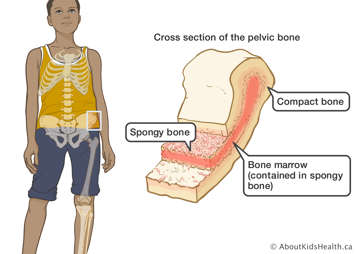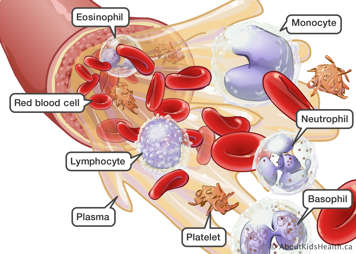Bone marrow is the spongy tissue inside our bones. All bones in newborn babies have active marrow, which means they are producing new marrow cells. By the time your child reaches young adulthood, the marrow inside the bones of the hands, feet, arms and legs stops producing new marrow cells. In adults, active marrow is found inside the spine, hip and shoulder bones, ribs, breastbone and skull. However, bone marrow found in the spine and hip has the richest source of bone marrow cells.

What does the marrow do?
Our bone marrow produces blood cells, called red blood cells, platelets and white blood cells.
Inside the marrow, blood cells start off as young, immature cells called stem cells. Once they mature and go into circulation in the blood stream, blood cells do not live for a long time. This is why our marrow continuously produces all three types of blood cells to keep us healthy.
Red blood cells
These cells are red because they are filled with a protein called haemoglobin. Oxygen and carbon dioxide attach to the iron that is in haemoglobin, allowing the red blood cell to transport oxygen to the body. The red blood cells also get rid of carbon dioxide, which leaves your body through the lungs when you breathe out.
Platelets
Platelets are blood cells that help the blood clot (stick together) to help stop bleeding at sites on the body that have been cut or injured. Platelets form the scab that is formed over a small cut.
White blood cells
White blood cells help the body fight against infection. There are many different types of white blood cells, which include:
- Lymphocytes, neutrophils, and monocytes. These white blood cells fight against invading bacteria, viruses or fungi to help destroy infection. Each of these cells differs in appearance.
- Eosinophils and basophils. These white blood cells respond to allergens that can invade our bodies.

Immune system
Our immune system protects the body from disease. It kills unwanted micro-organisms, such as bacteria and viruses, that may invade our bodies.
How does our immune system fight against infection?
Small glands called lymph nodes are scattered throughout the body. Lymphocytes, which are made inside our marrow, enter the lymph nodes.
The lymphocytes travel between each node through channels called lymphatics. The lymphatic channels meet at large ducts that empty into a blood vessel. Lymphocytes enter the blood through these ducts to help fight infection.
There are three major types of lymphocytes, which play an important part of the immune system.
B-lymphocytes (B-cells)
These cells originate in the bone marrow. They make proteins called antibodies, which attach onto the surface of infection-causing microbes. Generally, these are Y or T shaped. Each type of antibody reacts to different microbes by sticking to molecules, called antigens, which sit on the surface of the microbe. It is this antibody-antigen binding that triggers B-cells to grow and produce more antibodies, which fight infection.
T-lymphocytes (T-cells)
These cells mature in the thymus, which is a small organ in the upper chest, just behind the sternum (breastbone). T-cells help B-cells make antibodies against invading bacteria, viruses or other microbes. Unlike B-cells, T-cells engulf and destroy pathogens directly, after binding to the antigen on the surface of the microbe.
Natural killer (NK) cells
These are a type of lymphocyte that directly attacks cells that have been infected by a virus.
